Asus ZenBook Pro 14 review: a powerful laptop with a touchpad that doubles up as a second display
Asus ZenBook Pro 14 has a fancy gimmick as well as some impressive specs

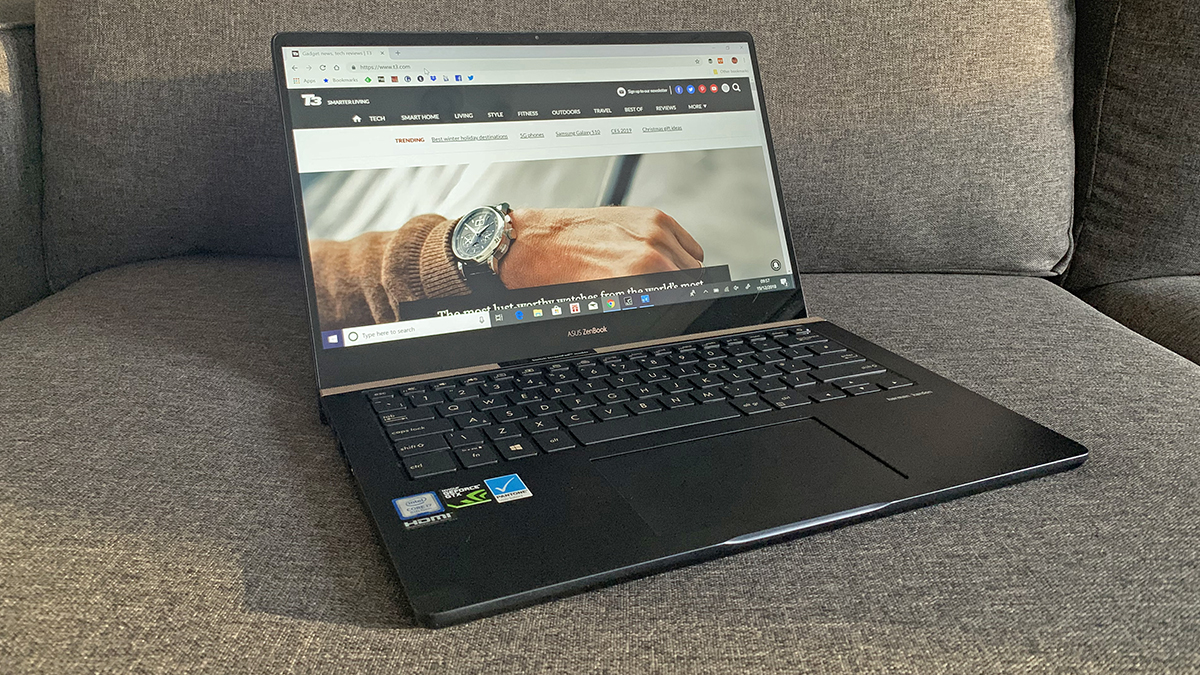
The Asus ZenBook Pro 14 sits rather snugly in the middle of the budget laptops and the high-end laptops – you get some very good specs, a really rather tasteful design, and a quirky touchpad feature for your money. It's not perfect but it gets a lot of things right.
-
+
Mostly high-end specs list
-
+
Attractive overall design
-
+
Bright, vibrant touchscreen
-
-
Battery life is average
-
-
Gamers will want more power
-
-
ScreenPad can be a distraction
Why you can trust T3

Asus ZenBook 14 Pro specifications

CPU: 1.8GHz Intel Core i7-8565U processor (quad-core, 8MB cache, up to 4.6 GHz)
GPU: Nvidia GeForce GTX 1050 Max-Q graphics (2GB RAM), Intel UHD Graphics 620
RAM: 8GB DDR4
Screen: 14-inch, FHD (1920 x 1080)
Storage: 256GB SSD
Ports: 1 x USB-C 3.1, 1 x USB-A 3.1, 1 x USB-A 2.0, 1 x HDMI, 1 x audio jack
Camera: Webcam
Dimensions: 32.3 x 22.5 x 1.79 cm (12.71 x 8.85 x 0.7 inches)
Weight: 1.6 kg (3.52 pounds)
OS: Windows 10
If you want a top-tier laptop these days you've got plenty of options to pick from: the likes of Dell, Apple, HP and several others make premium notebooks that cost a lot, but manage to justify their high price in the looks and performance departments. And that's before you even look at the tablets that can put in a shift as laptops too.
Step forward then the Asus ZenBook Pro 14, a laptop with the specs, the build quality, and the asking price to command a place somewhere near the top table of portable computers in 2018. Does it have enough to compete? We'll fill you in on all the details here.
Asus ZenBook Pro 14 review: price and availability
You can pick up the Asus ZenBook Pro in either 15 or 14-inch models, and with a variety of internal specs. Here we're looking at the 14-inch model (UX480F), with an Intel Core i7 processor and some of the best specs around (of which more later).
The laptop is on sale now and this model will set you back around £1,300 at most online retailers: that's a lot of money but less than you might pay for something of similar power from Dell or Apple. The 15-inch model, 4K display and all, costs significantly more.
Asus ZenBook Pro 14 review: design and build quality

Asus ZenBook Pro 14
Asus know how to make a good-looking laptop, that's been well established for a number of years now, and the ZenBook Pro 14 isn't a disappointment in that regard. This laptop doesn't just look good though: it feels good. There's a premium vibe to the materials and just the right balance between heft and portability.
Speaking of portability, if you spend a lot of your day lugging round a laptop, the 14-inch version of the ZenBook Pro might be a lot more appealing to you than the bigger one (though there are trade-offs of course).
Deep Dive Blue is your one and only colour choice but we like it, and we like the subtle gold accents around the edges and on the logo. That gold finish extends to the keys, which by the way are a pleasure to type on – solid and responsive.
Get all the latest news, reviews, deals and buying guides on gorgeous tech, home and active products from the T3 experts
And so to one of the laptop's main selling points, that we haven't mentioned yet: the touchpad, which also doubles as a second screen. Asus is calling it a ScreenPad, and it might well appeal, if you can find a use for it. We, alas, couldn't. App support is limited (Microsoft Office and Spotify are the two stand outs), and even when programs do make use of the functionality, it still feels a bit gimmicky.
One of the ScreenPad modes emulates a second display, so it's like having another monitor plugged in. You can, for example, run a YouTube video full screen on the trackpad, or a Twitter timeline. The problem then is that you can't use it as a trackpad any more, so you'd better have a mouse handy.
It's kind of cool, for a bit, but we couldn't really get much use out of it (you'd be forgiven for drawing parallels with the Touch Bar added to recent MacBook Pros...). You can still switch off the ScreenPad functionality though, if you don't like it, and use it just like a normal trackpad, so it's hard to count this as a point in the negative column for the ZenBook Pro 14 – it's more like a handy bonus for those who can actually work out what it might be good for.
We should point out that the chassis and case lid are fingerprint magnets, but this is hardly unique to the ZenBook 14 Pro, and probably not a huge concern for you.
Asus ZenBook Pro 14 review: hardware and screen
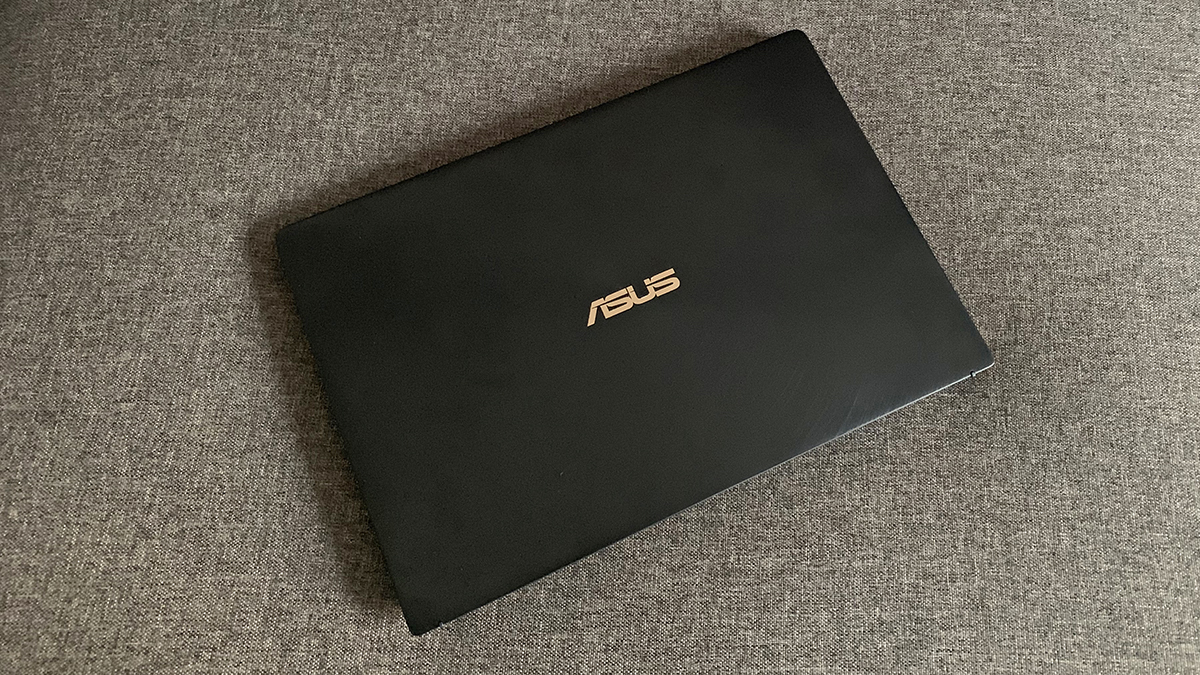
Asus ZenBook Pro 14
The ZenBook Pro 14 runs at a rather disappointing resolution of 1,920 x 1,080 pixels, but we didn't have any complaints about the sharpness and the richness of the display. We're also big fans of the minimal bezels on show here: the laptop has an 86 percent screen-to-body ratio, and looks really impressive in use.
Our model had the optional touchscreen functionality, which you may find useful, but which we didn't end up taking advantage of that much. Like the ScreenPad, it's an extra that you might find yourself occasionally turning to. As thin as the bezels are, there's still room for a webcam at the top of the screen.
The review unit came with an 8th-gen quad-core Intel Core i7-8565U processor, 8GB of RAM, and 256GB of SSD storage – not too shabby at all, but not the very best specs out there. You can up the RAM (to 16GB) and the storage (to 1TB) but we haven't seen those models on sale yet. It's also possible to save some money with an Intel Core i5-8265U processor configuration, though again we haven't seen it online at any retailers at the time of writing.
As for graphics, our Asus ZenBook Pro 14 came equipped with an Nvidia GeForce GTX 1050 Max-Q chipset and 2GB of video RAM. That's a respectable graphics card that makes the ZenBook Pro 14 a serviceable gaming machine, but it's not quite the best in the business.
In short, it's a powerful machine that's going to eat up day-to-day tasks and perform very well with high-end, demanding tasks too. We didn't notice any real lag when image editing or crowding the screen with open browser tabs, and when it came to benchmarks and gaming, the Asus ZenBook Pro 14 performed very well too (of which more in a moment).
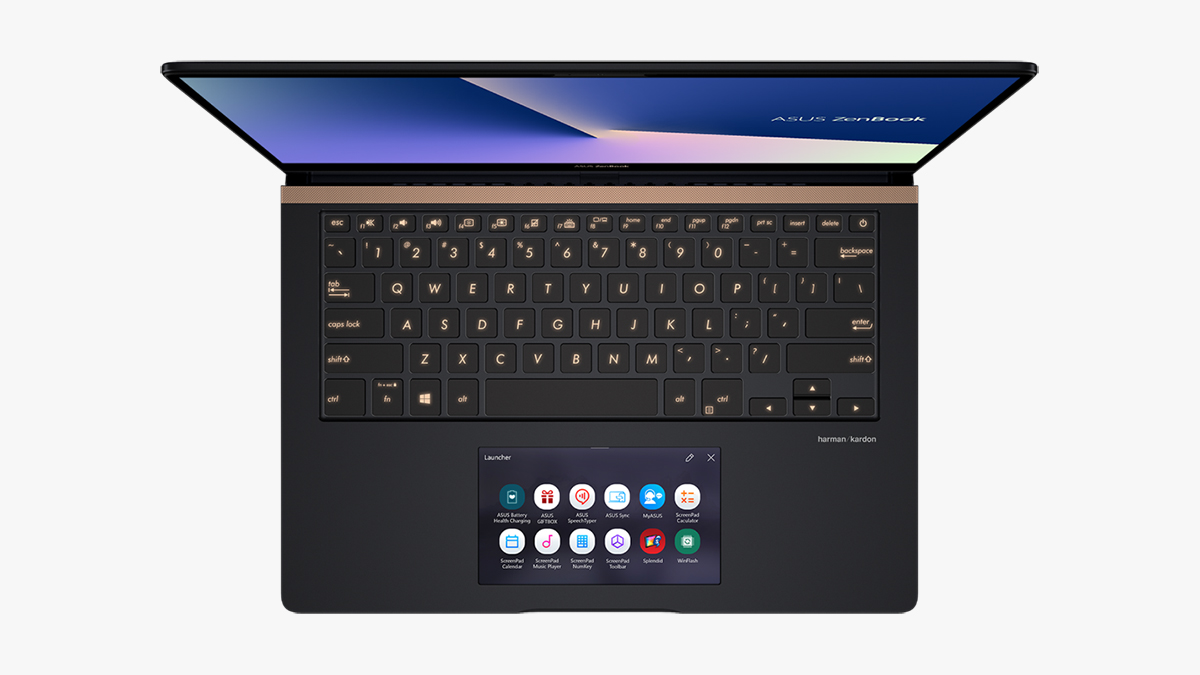
Asus ZenBook Pro 14
One benefit you do get from that 1080p screen is better battery life, but the Asus ZenBook Pro 14 isn't going to win any awards in this department. We found ourselves getting 7-8 hours between charges, which is fine for long journeys or a trip out of the office, but if you're out for the whole day you might be hunting for a mains socket by the end.
A little light word processing an emailing would knock the battery life down by about 10 percent an hour on the default settings, we found; a hour of Netflix streaming with the volume at a reasonable level would see around a 20 percent decrease.
Of course, as with every laptop, you've got ways to extend battery life by dimming the screen and so on – Asus quotes 12.5 hours between charges, which seems very optimistic to us – but those were the sort of figures we saw during our testing.
We touched on portability earlier, and at 1.6 kg (3.52 pounds) and 22.5 cm (8.85 inches) thick when closed, the Asus ZenBook Pro 14 is just about svelte and light enough to feel like you could lug it around in a backpack all day or hold it up with one hand for an extended period of time.
Audio – built with the help of Harman Kardon – is better than average, but not likely to make you choose this over a different laptop for the sound quality alone. It's just fine for movies and shows, but it's not seriously going to replace your Echo (or whatever dedicated speaker you have) as a music jukebox.
Finally, with the ports you get two USB-A ports, one USB-C port, a HDMI jack, and an audio jack. That should be enough for all but the most demanding of users, and everything is tastefully integrated too.
Asus ZenBook Pro 14 review: gaming and performance
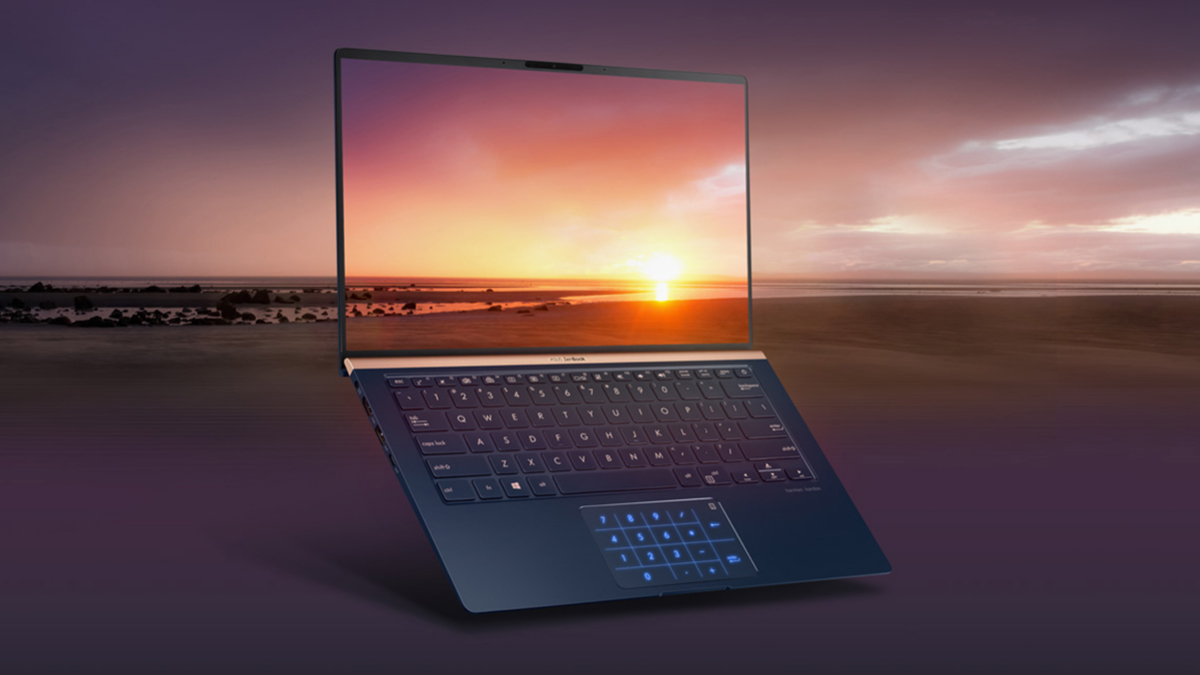
Asus ZenBook Pro 14
GeekBench 4 benchmark scores

[CPU test]
Single-Core: 4,508
Multi-Core: 13,959
[Compute test]
OpenCL Score: 70,027
When it comes to the raw performance figures, we found the ZenBook Pro 14 from Asus a serious performer for demanding tasks like video editing and gaming, without troubling the best gaming laptops at the very top-of-the-range.
That's mainly down to the Nvidia GeForce GTX 1050 Max-Q discrete graphics chip installed inside, which is certainly going to give you much better performance than integrated Intel graphics, without reaching the very highest levels. It's a chip optimised for efficiency rather than power, so while you should be able to play any game you like, you won't necessarily be able to ramp them up to the best quality settings.
Make no doubt about it though, the Asus ZenBook Pro 14 is a very nippy machine, thanks to that 8th-gen, Intel i7 processor at the heart of everything and 8GB of RAM. You'll be able to load up as many apps and windows on screen as you like without suffering any slowdown at all.
3DMark Advanced Edition benchmark scores
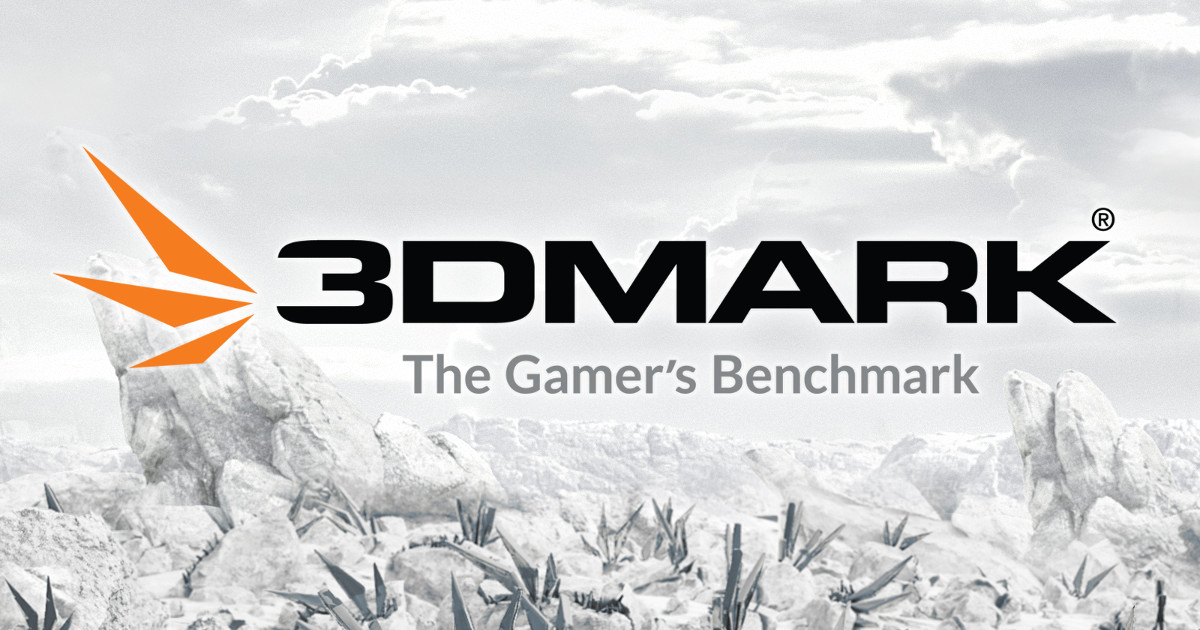
Time Spy: 1,629
Fire Strike: 4,658
Sky Diver: 15,366
We did find the Asus ZenBook Pro 14 occasionally running hot, as we tried to push it to its limits, and while we were running some of the benchmarks you can see in the adjacent boxes here. That's really a consequence of the form factor though, and isn't specifically a problem with the ZenBook Pro 14 – but if you are going to do a lot of gaming then we'd recommend sticking this on a desk rather than your lap.
We weren't able to run any of the most demanding games, but we did test out a few less intensive titles (think Lego Indiana Jones) and the ZenBook Pro 14 passed with flying colours.
Based on the benchmarks we ran, the Asus ZenBook Pro 14 shows itself to be very strong in the CPU and computing departments, and satisfactory in terms of gaming – when you put it up against scores from competitors like the Dell XPS 15 2-in-1 and the HP Omen 15, you can see it lags behind in the gaming stakes but excels in the GeekBench scores.
In other words, it'll chew through some intensive video encoding for you very quickly, but you might have to dial down the resolution a little when you're playing the top-end games. Adjust your buying decisions accordingly (remember to factor in prices too).
Asus ZenBook Pro 14 review: verdict
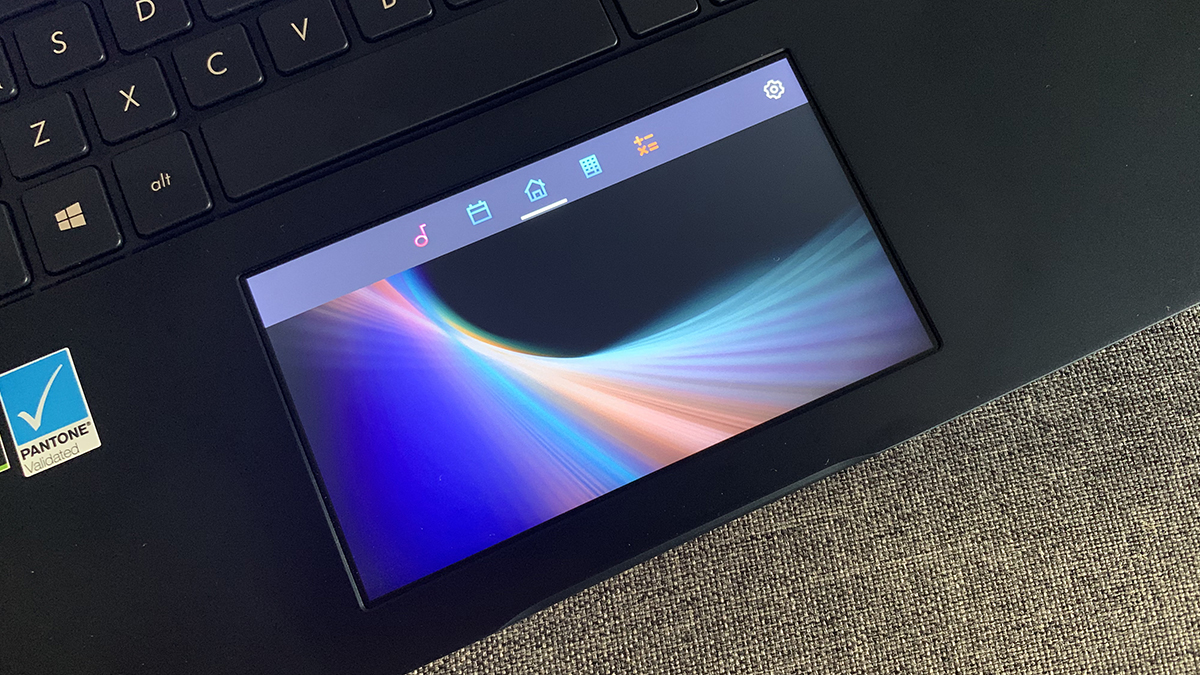
Asus ZenBook Pro 14
The Asus ZenBook Pro 14 is a laptop that scores highly in a lot of departments. It looks really nice, it has plenty of power under the hood, and the price you're going to pay represents decent value for what you get in return.
We felt the ScreenPad was a bit gimmicky, but considering you can disable it, it's hardly a dealbreaker. Battery life is no more than satisfactory, really, but again it's not really enough to take too much of a shine off the package as a whole.
In terms of performance, the inclusion of the Nvidia GeForce GTX 1050 Max-Q graphics chip is a welcome one: it's not going to work wonders but it does provide enough oomph so that you should be able to get respectable frame rates from most games. On the raw computing side, the Intel Core i7 CPU is going to be able to take everything you can throw at it and then some.
Overall, we liked the Asus ZenBook Pro 14 a lot, and would gladly use it as our main computer – a sure sign at the end of a review that a device has impressed. There are more stylish and more powerful laptops out there, for sure, but they also tend to be more expensive, and for a machine that's pricey but not too pricey, this is well worth a look.
Dave has over 20 years' experience in the tech journalism industry, covering hardware and software across mobile, computing, smart home, home entertainment, wearables, gaming and the web – you can find his writing online, in print, and even in the occasional scientific paper, across major tech titles like T3, TechRadar, Gizmodo and Wired. Outside of work, he enjoys long walks in the countryside, skiing down mountains, watching football matches (as long as his team is winning) and keeping up with the latest movies.
